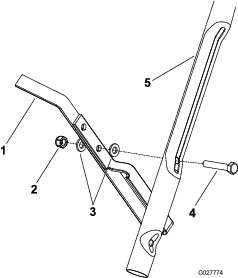| Maintenance Service Interval | Maintenance Procedure |
|---|---|
| Before each use or daily |
|
Introduction
Read this information carefully to learn how to operate and maintain your product properly and to avoid injury and product damage. You are responsible for operating the product properly and safely. Keep this manual for future reference.
You may contact Toro directly at www.Toro.com for product safety and operation training materials, accessory information, help finding a dealer, or to register your product.
Whenever you need service, genuine Toro parts, or additional information, contact an Authorized Service Dealer or Toro Customer Service and have the model and serial numbers of your product ready. Figure 1 identifies the location of the model and serial numbers on the product.
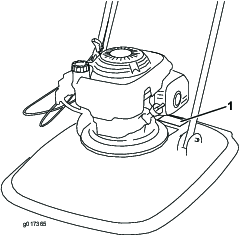
Write the product model and serial numbers in the space below:
This manual identifies potential hazards and has safety messages identified by the safety alert symbol (Figure 2), which signals a hazard that may cause serious injury or death if you do not follow the recommended precautions.

This manual uses 2 words to highlight information. Important calls attention to special mechanical information and Note emphasizes general information worthy of special attention.
This product complies with all relevant European directives. For details, see the separate product specific Declaration of Conformity (DOC) sheet.
Net Torque: The gross or net torque of this engine was laboratory rated by the engine manufacturer in accordance with the Society of Automotive Engineers (SAE) J1349. As configured to meet safety, emission, and operating requirements, the actual engine torque on this class of machine will be significantly lower. Go to www.Toro.com to view specifications on your machine model.
Do not tamper with the engine controls or alter the governor speed; doing so may create an unsafe condition resulting in personal injury.
Safety
This machine has been designed in accordance with EN 14910.
Improperly using or maintaining this machine can result in injury. To reduce the potential for injury, comply with these safety instructions.
Toro designed and tested this machine to offer reasonably safe service; however, failure to comply with the following instructions may result in personal injury.
To ensure maximum safety and best performance, and to gain knowledge of the product, it is essential that you and any other operator of the machine read and understand the contents of this manual before the engine is ever started. Pay particular attention to the safety alert symbol (Figure 2) which means Caution, Warning, or Danger—“personal safety instruction.” Read and understand the instruction because it has to do with safety. Failure to comply with the instruction may result in personal injury.
General Machine Safety
This cutting machine is capable of amputating hands and feet and of throwing objects. Failure to observe the following safety instructions could result in serious injury or death.
Training
-
Read the instructions carefully. Be familiar with the controls and the proper use of the equipment.
-
Never allow children or people unfamiliar with these instructions to use the machine. Local regulations can restrict the age of the operator.
-
Keep in mind that the operator or user is responsible for accidents or hazards occurring to other people or their property.
-
Understand explanations for all pictograms used on the machine or in the instructions.
Gasoline
WARNING-Gasoline is highly flammable. Take the following precautions.
-
Store fuel in containers specifically designed for this purpose.
-
Refuel outdoors only and do not smoke while refueling.
-
Add fuel before starting the engine. Never remove the cap of the fuel tank or add gasoline while the engine is running or when the engine is hot.
-
If gasoline is spilled, do not attempt to start the engine but move the machine away from the area of spillage and avoid creating any source of ignition until gasoline vapors have dissipated.
-
Replace all fuel tank and container caps securely.
Preparation
-
While cutting, always wear substantial, slip-resistant footwear and long trousers. Do not operate the equipment when barefoot or wearing open sandals.
-
Thoroughly inspect the area where the equipment is to be used and remove all stones, sticks, wires, bones and other foreign objects.
-
Before using, always visually inspect to see that guards and safety devices, such as deflectors, are in place and working correctly.
-
Before using, always visually inspect to see that the lines, retaining bolts, and flexi blade assembly are not worn or damaged. Replace worn or damaged lines in sets to preserve balance.
-
Wear safety glasses or goggles at all times when operating the trimmer.
-
Wear hearing protection.
Starting
-
Do not tilt the machine unless the machine must be tilted for starting. In this case, do not tilt it more than absolutely necessary and lift only the part which is away from the operator.
-
Start the engine carefully according to instructions and with feet well away from the flexi blade.
Operation
-
Never cut while people, especially children, or pets are nearby.
-
Cut only in daylight or in good artificial light.
-
Avoid operating the trimmer in wet grass, or take additional precautions to avoid slipping.
-
Stay alert for holes in the terrain and other hidden hazards.
-
Do not put hands or feet near or under rotating parts.
-
Never pick up or carry a machine while the engine is running.
-
Use extreme caution when reversing or pulling a pedestrian-controlled machine toward you.
-
Walk, never run.
-
Slopes:
-
Do not cut excessively steep slopes.
-
Watch for holes, ruts, bumps, rocks, or other hidden objects. Uneven terrain could cause a slip and fall accident. Tall grass can hide obstacles.
-
Use caution near drop-offs, ditches, or embankments. You could lose your footing or balance.
-
When using the machine, always keep both hands on the handlebar.
-
When cutting steep slopes from the top of the slope and a longer reach is needed, never tie the machine to a rope; use the extended handlebar kit option.
-
Exercise extreme caution when on slopes.
-
Always be sure of your footing on slopes.
-
-
Stop the engine if the machine must be tilted for transportation when crossing surfaces other than grass and when transporting the machine to and from the area to be cut.
-
Do not operate the engine in a confined space where dangerous carbon monoxide and other exhaust gasses can collect.
-
Stop the engine
-
whenever you leave the machine.
-
before refueling.
-
before making height adjustment unless adjustment can be made from the operating position.
-
-
Stop the engine and disconnect the spark-plug wire.
-
before clearing blockages.
-
before checking, cleaning or working on the machine.
-
after striking a foreign object, inspect the machine for damage and make repairs before restarting and operating the machine.
-
if the machine starts to vibrate abnormally (check immediately).
-
-
Lightning can cause severe injury or death. If you see lightning or hear thunder in the area, do not operate the machine; seek shelter.
-
Watch out for traffic when crossing or near roadways.
Maintenance and Storage
-
Keep all nuts, bolts, and screws tight to be sure that the equipment is in safe working condition.
-
Do not use pressure-cleaning equipment on the machine.
-
Never store the equipment with gasoline in the tank and inside a building where fumes can reach an open flame or spark.
-
Allow the engine to cool before storing in any enclosure.
-
To reduce the fire hazard, keep the engine, silencer, battery compartment and gasoline storage area free of grass, leaves, or excessive grease.
-
Replace worn or damaged parts for safety.
-
Replace faulty silencers.
-
If the fuel tank has to be drained, do this outdoors.
-
Do not change the engine governor settings or overspeed the engine. Operating an engine at excessive speed can increase the hazard of personal injury.
-
Be careful while adjusting the machine to prevent entrapment of the fingers between the moving flexi blade and fixed parts of the machine.
-
To ensure the best performance and safety, purchase only genuine Toro replacement parts and accessories. Do not use will fit parts and accessories; they may cause a safety hazard.
Hauling
-
Use care when loading or unloading the machine into a trailer or a truck.
-
Tie the machine down securely using straps, chains, cable, or ropes.
Sound Pressure
This machine has a sound pressure level at the operator’s ear of 90 dBA. This includes an Uncertainty Value (K) of 2 dBA. The sound pressure level was determined according to the procedures outlined in EN 14910.
Sound Power
This machine has a guaranteed sound power level of 100 dBA. This includes an Uncertainty Value (K) of 2 dBA. The sound power level was determined according to the procedures outlined in ISO 11094.
Caution
Long-term exposure to noise while operating the machine may cause some hearing loss.
Wear adequate hearing protection whenever you operate the machine for an extended period of time.
Vibration
Measured vibration level for the left hand = 7.7 m/s2
Measured vibration level for the left hand = 5.5 m/s2
Uncertainty Value (K) = 3 m/s2
The measured values were determined according to the procedures outlined in EN 14910.
Caution
Long-term exposure to vibration while operating the machine may cause some numbness in the hands and wrists.
Wear gloves that dampen the vibration whenever you operate the machine for an extended period of time.
Safety and Instructional Decals
Important: Safety and instruction decals are located near areas of potential danger. Replace damaged decals.

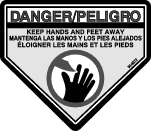
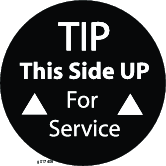
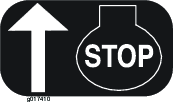

Setup
Assembling the Handle
-
Slide 2 bushings into the frame.
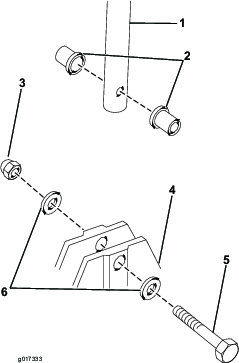
-
Place the lower handle between the bushes and secure it with 1 handlebar bolt, 2 washers, and 1 nut.
Note: Place the lower handle between the bushes with the kick stop assembly on the right hand side.
-
Repeat for the opposite side.
-
Align the holes on the upper handle with the lower handle.

-
Fit the U-bolt through the upper and lower handle and secure it with a washer and a hand wheel.
-
Attach the throttle assembly to the outside of the handlebar and secure it with a nut and a pan screw.
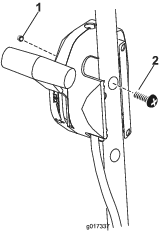
Installing the Footstop
Filling the Engine with Oil
Important: Your machine does not come with oil in the engine. Before starting the engine, fill the engine with oil.
Max. fill: 0.59 L (20 oz), type: Multigrade Mineral 10W-30 oil with an API service classification of SF, SG, SH, SJ, SL, or higher.
-
Move the machine to a level surface.
-
Remove the dipstick (Figure 7).
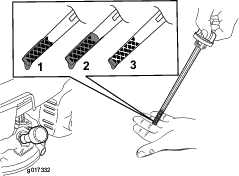
-
Slowly pour oil into the oil fill hole, wait 3 minutes, and check the oil level on the dipstick by wiping the dipstick clean and then inserting, but not screwing in, the oil fill cap into the hole (Figure 8).
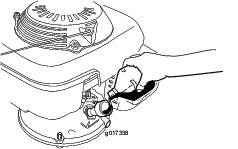
Note: Fill the engine crankcase with oil until the dipstick indicates that the engine oil level is correct as shown in Figure 7. If you overfill the engine with oil, remove the excess oil as directed in Changing the Engine Oil.
-
Install the dipstick and hand tighten it securely.
Important: Change the engine oil after the first 5 operating hours; change it yearly thereafter. Refer to Changing the Engine Oil.
Product Overview
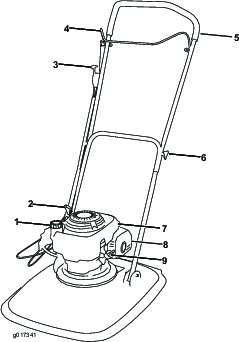
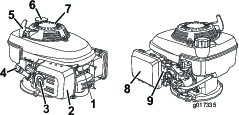
| Model | Cutting width | Product width | Product height | Length | Weight | Engine rpm | Cutting height range |
| 02612 | 457 mm (18 inches) | 574 mm (22.6 inches) | 1000 mm (39.3 inches) | 1,400 mm (55 inches) | 17.7 kg (39 lbs) | 3,150 +0/-100 | 16 mm – 36 mm (0.6 inches – 1.4 inches) |
Operation
Filling the Fuel Tank
Danger
Gasoline is extremely flammable and explosive. A fire or explosion from gasoline can burn you and others.
-
To prevent a static charge from igniting the gasoline, place the container and/or machine directly on the ground before filling, not in a vehicle or on an object.
-
Fill the tank outdoors when the engine is cold. Wipe up spills.
-
Do not handle gasoline when smoking or around an open flame or sparks.
-
Store gasoline in an approved fuel container, out of the reach of children.
Recommended Fuel:
-
For best results, use only clean, fresh (less than 30 days old), unleaded gasoline with an octane rating of 87 or higher ((R+M)/2 rating method).
-
Ethanol: Gasoline with up to 10% ethanol (gasohol) or 15% MTBE (methyl tertiary butyl ether) by volume is acceptable. Ethanol and MTBE are not the same. Gasoline with 15% ethanol (E15) by volume is not approved for use. Never use gasoline that contains more than 10% ethanol by volume, such as E15 (contains 15% ethanol), E20 (contains 20% ethanol), or E85 (contains 85% ethanol). Using unapproved gasoline may cause performance problems and/or engine damage which may not be covered under warranty.
-
Do not use gasoline containing methanol.
-
Do not store fuel either in the fuel tank or fuel containers over the winter unless a fuel stabilizer is used.
-
Do not add oil to gasoline.

Checking the Engine-Oil Level
-
Move the machine to a level surface.
-
Remove the dipstick and wipe it with a clean cloth.
-
Insert, but do not screw in, the dipstick into the oil fill hole.
-
Remove the dipstick and check it.
-
To determine the proper oil level on the dipstick, refer to Figure 12).

-
If the oil level is low, slowly pour oil into the oil fill hole, wait 3 minutes, and check the oil level on the dipstick by wiping the dipstick clean and then inserting, but not screwing in, the oil fill cap into the hole.
Note: Max. fill: 0.59 L (20 oz) Multigrade Mineral 10W-30 oil with an API service classification of SF, SG, SH, SJ, SL, or higher.
Note: Fill the engine crankcase with oil until the dipstick indicates that the engine oil level is correct as shown in Figure 12. If you overfill the engine with oil, remove the excess oil as directed in Changing the Engine Oil.
-
Install the dipstick and hand tighten it securely.
Important: Change the engine oil after the first 5 operating hours; change it yearly thereafter. Refer to .
Adjusting the Cutting Height
Warning
Adjusting the cutting height may bring you into contact with moving parts, causing serious injury.
-
Stop the engine and wait for all moving parts to stop.
-
Wear gloves while handling the flexi blade.
Caution
If the engine has been running, the muffler will be hot and can severely burn you. Keep away from the hot muffler.
Adjust the cutting height as desired.
-
Turn the fuel switch to the Off position.
-
Disconnect the wire from the spark plug.
-
Tilt the machine on its left side.
-
Wearing protective gloves, remove the flexi blade.
-
Remove the retaining bolt.
-
Reposition the spacers to the desired height, then reinstall the flexi blade (Figure 13).
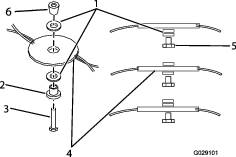
Note: The large spacer must be positioned directly below the impeller at all times.
Starting the Engine
-
Place the throttle control to the choke position, ensure that the fuel switch is in the On position.

-
Hold the engine-stop handle against the handle.
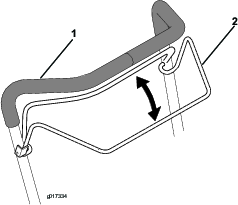
-
Place your foot on the deck and tilt the machine towards you (Figure 16).
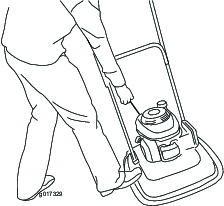
-
Pull the recoil start handle.
Note: If the machine does not start after several attempts, contact an Authorized Service Dealer.
Adjusting the Choke
Use the throttle assembly to adjust the choke (Figure 17).
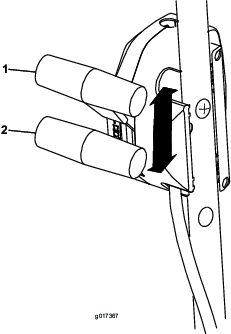
Stopping the Engine
| Maintenance Service Interval | Maintenance Procedure |
|---|---|
| Before each use or daily |
|
To stop the engine, release the control bar (Figure 18).
Important: When you release the engine stop handle, both the engine and flexi blade should stop within 3 seconds. If they do not stop properly, stop using your machine immediately and contact an Authorized Service Dealer.
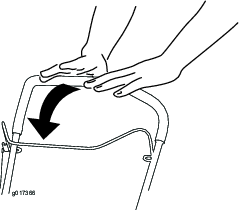
Operating Tips
General Cutting Tips
Warning
Operating the machine on slopes of greater than 45° will cause severe engine damage due to a lack of lubrication. Some of the potential damage could include stuck valves, scored pistons, or burned crank bearings.
-
Before operating on any slope, complete a site survey to determine the actual slope where you will operate the machine.
-
Do not operate the machine on slopes greater than 45°.
-
Clear the area of sticks, stones, wire, branches, and other debris that the flexi blade could hit.
-
Avoid striking solid objects with the flexi blade. Never deliberately trim over any object.
-
If the machine strikes an object or starts to vibrate, immediately stop the engine, disconnect the wire from the spark plug, and examine the machine for damage.
-
For best performance, install a new flexi blade before the cutting season begins.
-
Replace the flexi blade when necessary with a Toro replacement flexi blade.
Cutting Grass
-
Cut only about a third of the grass blade at a time. Do not cut below the 30 mm (1.2 inch) setting (02602/02604) or 32 mm (1.25 inch) setting (02606) unless the grass is sparse or it is late fall when grass growth begins to slow down. Refer to Adjusting the Cutting Height.
-
Cutting grass over 15 cm (6 inches) in length is not recommended. If the grass is too long, the machine may plug and cause the engine to stall.
-
Cut only dry grass or leaves. Wet grass and leaves tend to clump on the yard and can cause the machine to plug or the engine to stall.
Warning
Wet grass or leaves can cause serious injury if you slip and contact the flexi blade.
Trim only in dry conditions.
-
Alternate the cutting direction. This helps disperse the clippings over the lawn for even fertilization.
-
If the finished lawn appearance is unsatisfactory, try one or more of the following:
-
Replace the flexi blade.
-
Walk at a slower pace while cutting.
-
Raise the cutting height on your machine.
-
Cut the grass more frequently.
-
Overlap cutting swaths instead of cutting a full swath with each pass.
-
Cutting Leaves
-
After cutting the lawn, ensure that half of the lawn shows through the cut leaf cover. You may need to make more than one pass over the leaves.
-
Slow down your cutting speed if the machine does not cut the leaves finely enough.
Maintenance
Note: Determine the left and right sides of the machine from the normal operating position.
Recommended Maintenance Schedule(s)
| Maintenance Service Interval | Maintenance Procedure |
|---|---|
| After the first 5 hours |
|
| Before each use or daily |
|
| After each use |
|
| Every 100 hours |
|
| Before storage |
|
| Yearly |
|
Preparing for Maintenance
-
Stop the engine and wait for all moving parts to stop.
-
Disconnect the spark-plug wire from the spark plug (Figure 19) before performing any maintenance procedure.
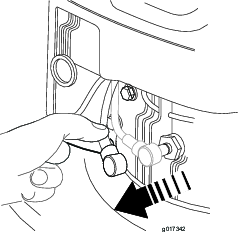
-
After performing the maintenance procedure(s), connect the spark plug wire to the spark plug.
Warning
Tipping the machine may cause the fuel to leak. Gasoline is flammable, explosive and can cause personal injury.
Run the engine dry or remove the gasoline with a hand pump; never siphon.
Important: Always tip the machine onto its side with the dipstick down.
Replacing the Air Cleaner
| Maintenance Service Interval | Maintenance Procedure |
|---|---|
| Yearly |
|
-
Press down on the latch tabs on top of the air cleaner cover (Figure 20).
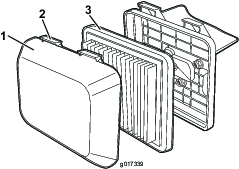
-
Open the cover.
-
Remove the filter (Figure 20).
-
Inspect the filter, and replace it if it is damaged or excessively dirty.
-
Inspect the paper air filter.
-
If the filter is damaged or is wet with oil or fuel, replace it.
-
If the filter is dirty, tap it on a hard surface several times or blow compressed air less than 207 kPa (30 psi) through the side of the filter that faces the engine.
Note: Do not brush the dirt off the filter; brushing forces dirt into the fibers.
-
-
Remove dirt from the air cleaner body and cover using a moist rag. Do not wipe dirt into the air duct.
-
Insert the filter into the air cleaner.
-
Install the cover.
Changing the Engine Oil
| Maintenance Service Interval | Maintenance Procedure |
|---|---|
| After the first 5 hours |
|
| Yearly |
|
-
Ensure that the fuel tank contains little or no fuel so that fuel does not leak out when you tip the machine onto its side.
-
Run the engine a few minutes before changing the oil to warm it.
Note: Warm oil flows better and carries more contaminants.
-
Disconnect the wire from the spark plug. Refer to Preparing for Maintenance.
-
Remove the dipstick.
-
Tip the machine onto its side, with the dipstick down, to drain the used oil out through the oil fill tube.
-
Return the machine to the operating position.
-
Slowly pour oil into the oil fill hole, wait 3 minutes, and check the oil level on the dipstick by wiping the dipstick clean and then inserting, but not screwing in, the oil fill cap into the hole.
Note: Max. fill: 0.59 L (20 oz), type: Multigrade Mineral 10W-30 oil with an API service classification of SF, SG, SH, SJ, SL, or higher.
Note: Fill the engine crankcase with oil until the dipstick indicates that the engine oil level is correct as shown in (Figure 21). If you overfill the engine with oil, remove the excess oil as directed in 5.

-
Install the dipstick and hand tighten it securely.
-
Dispose of the used oil properly at a local recycling center.
Servicing the Spark Plug
| Maintenance Service Interval | Maintenance Procedure |
|---|---|
| Every 100 hours |
|
Check the spark plug after every 100 operating hours. Use an Champion RN9YC spark plug or equivalent.
-
Stop the engine and wait for all moving parts to stop.
-
Disconnect the wire from the spark plug.
-
Clean around the spark plug.
-
Remove the spark plug from the cylinder head.
Important: Replace a cracked, fouled, or dirty spark plug. Do not clean the electrodes because grit entering the cylinder can damage the engine.
-
Set the gap on the plug to 0.76 mm (0.030 inch) (Figure 22).
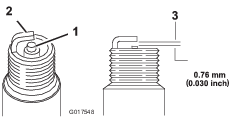
-
Install the spark plug and the gasket seal.
-
Torque the plug to 20 N-m (15 ft-lb).
-
Connect the wire to the spark plug.
Replacing the Flexi Blade
| Maintenance Service Interval | Maintenance Procedure |
|---|---|
| Yearly |
|
Important: You will need a torque wrench to install the flexi blade assembly properly. If you do not have a torque wrench or are uncomfortable performing this procedure, contact an Authorized Service Dealer.
Examine the flexi blade assembly whenever you run out of gasoline. If the flexi blade assembly is damaged, replace it immediately.
-
Disconnect the spark plug wire from the spark plug. Refer to Preparing for Maintenance.
-
Tip the machine onto its side, with the air filter up.
-
Use a block of wood to hold the flexi blade steady.
-
Remove the flexi blade by turning the bolt counterclockwise (Figure 23), saving all the mounting hardware.

-
Install the new flexi blade by turning the bolt clockwise (Figure 23),and install all the mounting hardware.
-
Use a torque wrench to tighten the bolt to 25 N-m (18 ft-lb).
Important: A bolt torqued to 25 N-m (18 ft-lb) is very tight. While holding the flexi blade with a block of wood, put your weight behind the ratchet or wrench and tighten the bolt securely. This bolt is very difficult to overtighten.
Cleaning the Machine
| Maintenance Service Interval | Maintenance Procedure |
|---|---|
| Before each use or daily |
|
| After each use |
|
Warning
The machine may dislodge material from under the machine housing.
-
Wear eye protection.
-
Stay in the operating position (behind the handle).
-
Do not allow bystanders in the area.
-
Tip the machine on its side.
-
Use a brush or compressed air to remove grass and debris from the exhaust guard, the top cowl, and the surrounding deck areas.
Storage
Store the machine in a cool, clean, dry place.
Preparing the Machine for Storage
Warning
Gasoline vapors can explode.
-
Do not store gasoline more than 30 days.
-
Do not store the machine in an enclosure near an open flame.
-
Allow the engine to cool before storing it.
-
On the last refueling of the year, add fuel stabilizer to the fuel as directed by the engine manufacturer.
-
Run the machine until the engine stops from running out of fuel.
-
Prime the engine and start it again.
-
Allow the engine to run until it stops. When you can no longer start the engine, it is sufficiently dry.
-
Disconnect the wire from the spark plug.
-
Remove the spark plug, add 30 ml (1 oz) of oil through the spark plug hole, and pull the starter rope slowly several times to distribute oil throughout the cylinder to prevent cylinder corrosion during the off-season.
-
Install the spark plug and tighten it with a torque wrench to 20 N-m (15 ft-lb).
-
Tighten all nuts, bolts, and screws.
Troubleshooting
| Problem | Possible Cause | Corrective Action |
|---|---|---|
| The engine does not start |
|
|
| The engine starts hard or loses power |
|
|
| The engine runs rough |
|
|
| The machine or engine vibrates excessively |
|
|
| There is an uneven cutting pattern |
|
|
